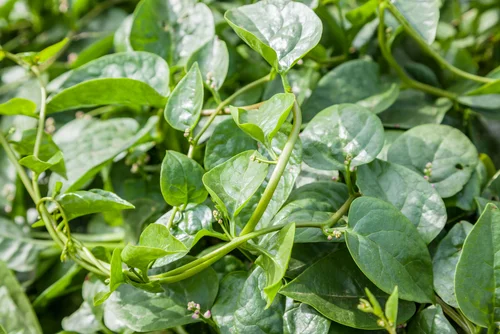Spinach
Malabar spinach is not related to common spinach but it has a similar taste and can be cooked in the same way. Unlike common spinach, this tender perennial does well in the heat.
VarietiEs
Malabar Spinach is a fast growing vine that produces semi-succulent leaves with red flowers. You may find it hard to buy a particular variety; it's usually only listed in seed catalogs as red or green vine.
WHERE SPINACH THRIVES
Regional compatibility
Perennial spinach is a tropical plant that thrives in hot, humid climates. It can be grown as a perennial in most southern states that do not experience winter frost. Even the lightest frost will kill this plant.
Optimal shade & sun
New Zealand spinach prefers hot, humid and full sun conditions for vigorous growth. You can increase the size of the leaf if you grow it in partial shade but the plant will grow more slowly.
RESILIENCE
Adaptability to climate extremes. Perennial spinach is a heat-loving green that thrives even when temperatures soar over 90 degrees. On the other hand, the lightest frost will turn this plant to mush. Malabar spinach is very drought tolerant and while it won't grow to its full potential in dry conditions, it will produce scrumptious greens. This summer green can also tolerate saline soils and short periods of flooding. It's a deliciously versatile perennial in mild winter locations found in the South. In Northern climates it's best grown as a summer annual.
Drought resistance. This tropical plant is very drought tolerant. While it won't grow to its full potential in dry conditions, it will produce scrumptious greens all summer long with little fuss. Water stress can cause the plant to flower, giving the succulent leaves a slightly bitter taste.
PREP YOUR SOIL
Optimal soil type. New Zealand spinach can grow in a variety of soil conditions but loves the fertile and moist soils of the tropics best of all. When it's time to plant this perennial, heap organic matter onto the soil – it can't get too much.
PLANTING
When planting indoors. Perennial spinach loves the heat so in cooler regions with short growing seasons it is best to start this plant inside, six to eight weeks before the last frost. Spinach seeds are very tough and require patience. Waiting for them to germinate can take up to three weeks. Soak the seeds overnight or scarify them to hasten germination. To scarify the seed, rub it with sandpaper or scrape it with a knife. The idea is to rough up the outer coating so water can enter the seed and prompt growth. Wait to transplant your spinach until well after the danger of frost has passed.
When planting in the garden. In warm climates with a long growing season, seeds can be planted directly in the garden. Keep the soil moist and weed-free while waiting for the seeds to take hold. Plants will not grow much until the heat of the summer when night temperatures climb above 60 degrees. You can also grow spinach from cuttings. The stem will quickly produce roots where ever it touches moist soil. If you want your spinach to have a healthy root stem, bend a few vines so they touch the soil. This will create a mat of roots below the surface that will feed and water your spinach.
Growing
Perennial spinach is a vining perennial and will need the support of a trellis to keep it off the ground. All you need to make a trellis is material sturdy enough to support the weight of the climbing plant. Once the summer heat has arrived, perennial spinach experiences rapid growth, seemingly sprouting a few inches every day. As the nights begin to cool, it will stop growing taller. It'll just grow fuller. There is no need to prune your plants.
WaterinG
Once perennial spinach is established, it doesn't need much water. The warmer the region you live in, the more water it will need. A good general rule is to soak the soil until it is wet two inches below the soil surface. Thirsty plants can get a tad bitter.
Mulching
Perennial spinach needs a lot of moisture to keep climbing tall. Mulch the soil with 2 inches of straw to keep moisture from leaving the soil and help fight against weeds.
CHALLENGES
Pests. Malabar spinach is essentially pest resistant. It is sensitive to destructive nematodes, tiny creatures that live in the soil, that feed on the roots. It is very difficult to control nematode populations because they are so small and abundant. If nematodes are a problem, consider planting in a new location.
Diseases. Fungal leaf spot can infect perennial spinach. It appears as round dots that cover the leaves and give your spinach a festive polka dot appearance. Infected leaves can still be eaten. Spraying neem or sulfur on the leaves can curb the spread of this disease.













